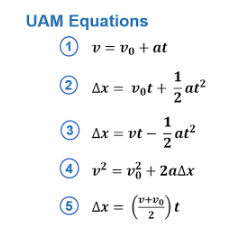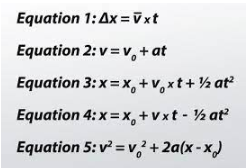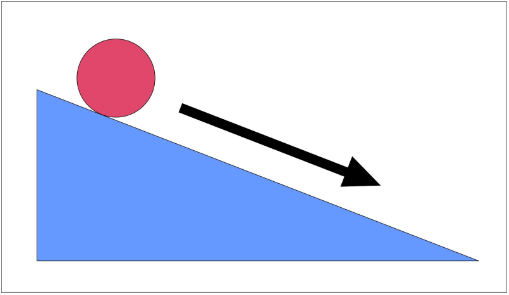Uniform Accelerated Motion in 1D
Uniform Accelerated Motion in 1D
Motion with constant acceleration in all directions (Uniformly Accelerated Motion)
If an object experiences constant acceleration, how do you expect its motion to evolve? Keep in mind that constant acceleration implies a constant rate of change in velocity, since acceleration is defined as the rate of change of velocity (according to the first equation of motion).
Equations of motion for uniformly accelerated motion (Uniform Acceleration Equations)
If we consider motion along a straight line with constant acceleration, there exist three equations of motion that can aid in determining one of the unknown variables:
V = u + at
X = ut + ½ at2
V2 = u2 + 2as
In the context of motion with constant acceleration, the following variables are commonly used:
v = final velocity
u = initial velocity
s = displacement
a = acceleration
t = time interval in which the particle is in consideration
The equations of motion can be derived using various methods, such as simple algebraic manipulation, graphical analysis, and calculus.
Keep in mind that it is important to follow the sign convention when using these equations. Typically, one direction is designated as positive and the other as negative. A classic example of uniformly accelerated motion is free fall, where the only force acting on the object is gravity. If we choose the upward direction to be positive, then the acceleration due to gravity (g) will have a negative sign, since it acts in the downward direction.
Uniformly Accelerated Motion In Dropping a Ball
For instance, let’s say we drop a ball from a height of 10 meters. At the moment of release, the ball has an initial velocity of zero. The acceleration due to gravity is approximately 9.8 m/s². As the ball falls, its velocity increases at a constant rate of 9.8 m/s².
Using the equations of motion for UAM, we can calculate various parameters related to the motion of the ball. For example, we can determine the time it takes for the ball to hit the ground.
Uniformly Accelerated Motion Definition
As we’ve been learning about kinematics, we’ve come across multiple unfamiliar variables and equations that help us solve problems related to motion in a single dimension. Our focus has been mainly on displacement and velocity, including their variations, and how the system’s initial conditions affect the overall motion and result. However, we haven’t yet explored acceleration.
It’s equally crucial to observe and comprehend how objects in motion accelerate when we start studying mechanics. You may have noticed that thus far, we have mostly been studying systems where acceleration is zero, or where acceleration remains consistent during a specific time frame. This is known as uniformly accelerated motion.
Uniformly Accelerated Motion Formulas
Surprisingly, the formulas for uniformly accelerated motion are the same as the kinematics equations we learned for motion in one dimension! When we initially introduced the core kinematics equations, we assumed that these formulas accurately describe the motion of an object in one dimension, provided that the acceleration remains constant. Earlier, we didn’t delve much into this aspect and merely hinted at it.
We can rearrange our kinematics equations and separate the acceleration variable so that we can readily use any of the formulas to determine the acceleration’s value, depending on various initial conditions.

Uniformly-Accelerated Motion
is a term used in Kinematics, which is a division of classical mechanics concerned with the position and motion of an object or a group of objects, without considering the forces responsible for its motion. For instance, the movement of a car during a race, including its changing position and velocity, can be explained using kinematics. The causes or factors responsible for the car’s motion are not considered in kinematics. Kinematics is sometimes referred to as “geometry in motion.”


Uniformly accelerated motion (UAM) is one of the most critical concepts in kinematics. It refers to the situation where an object or a system of objects moves with constant or uniform acceleration. In other words, the object’s velocity changes at a constant rate. Examples of objects undergoing constant acceleration include a ball rolling on an inclined plane.
Five Quantities for Uniform Acceleration Equations
The Uniform Acceleration Equations involve five quantities or variables, namely displacement, time, initial velocity, final velocity, and constant acceleration. We can distinguish each quantity from the others in the following ways:
- The term “Displacement,” represented by the symbol Δx or x−x0, pertains to the variation in an object’s position. It can also be defined as the shortest possible straight-line distance between the object’s initial and final positions. Displacement is a vector quantity since it has both magnitude and direction. The standard unit of displacement is meters (m) in the SI system, but other units like kilometers (km), miles (mi), and feet (ft) are also used to measure distance.
- The variable “Time,” represented by the symbol t, pertains to the duration that passes during the chosen observation period. It is also called elapsed time or time interval. The SI unit of time is the second (s), while other units such as minutes (min) or hours (h) are also used to measure time.
- The term “Initial velocity,” denoted by v0, pertains to the speed and direction of an object at the beginning of the observation period. It is a vector quantity, although sometimes only its magnitude or speed is considered. The standard unit of velocity is meters per second (m/s) in the SI system, while other units like kilometers per hour (km/h) and miles per hour (mph) are also used to express velocity.
- The term “Final velocity,” represented by v, pertains to the speed and direction of an object or body at the end of the observation period. Similar to initial velocity, it is a vector quantity described by its magnitude and direction. The unit of final velocity is the same as the initial velocity, which are m/s, km/hr, and mph.
The term “Constant acceleration,” denoted by a, refers to the change in velocity of an object over a specific time interval. When an object undergoes uniform changes in velocity, we call it constant acceleration. Like displacement, velocity, and initial velocity, acceleration is also a vector quantity, with an SI unit of meters per second squared (m/s2). Other units used to measure acceleration include km/h2 and mi/h2.
Uniform accelerated motion in 1D is a type of motion in which an object moves with a constant acceleration in a straight line.
Velocity is the rate of change of displacement with respect to time, while acceleration is the rate of change of velocity with respect to time.
Acceleration can be calculated as the change in velocity divided by the change in time: a = (v2 – v1) / (t2 – t1).
Uniform motion is when an object moves with a constant velocity (i.e., constant speed and direction), while uniformly accelerated motion is when an object moves with a constant acceleration.
The equation for calculating displacement in uniformly accelerated motion is: Δx = (v2 + v1) / 2 * t.
The final velocity in uniformly accelerated motion can be calculated using the equation: v2 = v1 + a * t.
Speed is the rate at which an object moves, while velocity is the rate at which an object changes its position in a particular direction.
The time taken in uniformly accelerated motion can be calculated using the equation: t = (v2 – v1) / a.
Some real-life examples of uniformly accelerated motion include a ball falling freely under the influence of gravity and a car speeding up or slowing down at a constant rate.
Scalar quantities only have magnitude (e.g., speed, temperature), while vector quantities have both magnitude and direction (e.g., velocity, force).






Still got a question? Leave a comment
Leave a comment